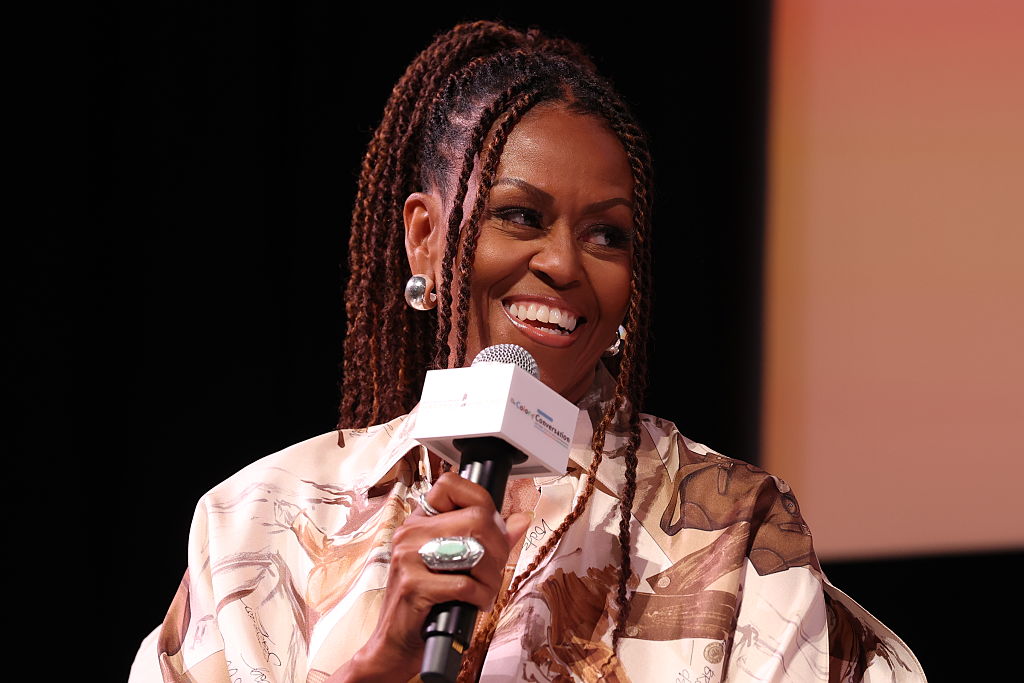After surviving an assassination attempt and winning reelection with a clear lead in the popular vote, Donald Trump was—briefly, and for the first time in his political career—seen by many pundits as incarnating the future rather than the past. In his first months back in the White House, the radicalism and vindictiveness of the administration have given jitters to a lot of independents who were key in helping him win and hardened opposition among his longtime critics. Any fleeting sense that the MAGA movement was culturally ascendent appears, at least for now, to be gone.
And yet, the conventional wisdom holds that a broader “vibe shift” is here to stay. Starting in 2013 or 2014, mainstream culture was for a decade dominated by the rise of wokeness, which can perhaps best be understood as a combination of a new left-identitarian ideology and a determination to expel anybody who violates its moral norms from the community of the righteous. But that culture has now supposedly foundered on its deep unpopularity. Opponents of wokeness have become much more willing to speak out about it in forceful terms. Cancellations have become much rarer. Wokeness, so the story goes, is on the way out.
I’m not so sure. The extremism of the Trump administration is now in danger of making left-leaning institutions and organizations as reactive as they were during his first term in office. While Joe Biden was in office, it was possible, with care and circumspection, to criticize wokeness, DEI or the more extreme forms of trans ideology from a left-of-center perspective. Now, any such dissent is once again starting to be perceived as “running interference for Trump.” The reversion to the culture which prevailed from 2016 through 2020 is only in its beginning stages, and it may never be fully consummated—but once you become attuned to its possibility, the signs are everywhere.
Here, in no particular order, are some recent news stories and personal experiences which suggest that reports of the death of wokeness are greatly exaggerated:
At a recent townhall, Tim Walz explained how Kamala Harris, his running mate, had lost to Donald Trump: “We let them define the issue on immigration. We let them define the issue on DEI. And we let them define what woke is.” The remedy Walz, a potential 2028 hopeful, prescribed for Democrats was a whole-hearted embrace of identity politics: “We got ourselves in this mess because we weren’t bold enough to stand up and say: ‘You’re damn right we’re proud of these policies. We’re gonna put them in. And we’re gonna execute them.’”
Arbitrary firings and cancellations are making a comeback. Sewell Chan is a distinguished journalist who has had stints as a senior editor at the New York Times and the Los Angeles Times as well as the editor-in-chief of the Texas Tribune. Less than a year ago, he was hired to rescue the ailing Columbia Journalism Review, and quickly scored some big journalistic hits. Then he was abruptly let go for reasons that resemble the witch hunts of a supposedly bygone era. The “misdeeds” which apparently led to his unceremonious firing include requiring a staff member to come into the office rather than letting him work from home and chastising another for a conflict of interest after repeatedly publishing in a radical publication shortly after writing a glowing profile of it. A hit piece also accused Chan of such heinous crimes as growing agitated while trying to get a major scoop online and standing too close to an employee in the process.
A faction of left-of-center liberals has for the past years been pushing a major American university to make some key reforms: they wanted to abolish mandatory diversity statements in faculty hiring; to make sure that orientations for incoming students emphasized the importance of open dialogue; and to push back against the friend-and-enemy thinking that suffused its DEI office. Until recently, a friend of mine who teaches at the university told me, numerous colleagues of hers were sympathetic to such common sense concerns. But that all changed once Donald Trump took office for the second time. In the latest faculty meetings, even comparatively moderate faculty members whom she had previously seen as allies were deeply hostile to the proposed changes. They now opposed any “concession” as “capitulating to Trump.”
When celebrity pollster Nate Silver recently sat down with Galen Druke, a former colleague of his at 538, to predict who might lead the Democratic Party into the 2028 presidential elections, they both agreed on the most likely candidate: “My first pick of the first-round draft is Alexandria Ocasio-Cortez,” Druke ventured. “F**k you! That was going to be my f**king first pick!,” Silver replied. Though AOC, perhaps the most famous national representative of “woke” politics, has poor approval ratings in the electorate as a whole, Silver emphasized how formidable she would be in a primary contest: she is very popular among Democratic voters, dominates the progressive lane, and is capable of commanding tremendous media attention.
Over the last months, I have attended a number of gatherings and conferences and dinners at which the leaders of some of America’s biggest foundations sought to figure out a strategy for how to defend American democracy. Few of them were as openly devoted to the most extreme forms of identitarian ideology as they might have been a few years ago; Robin DiAngelo and Ibram X. Kendi largely went unmentioned. But the reigning worldview at the top of the philanthropic world has changed little since the summer of 2020. The general consensus holds that voters turned to Trump because American democracy did not deliver for the “historically marginalized.” The solution supposedly revolves around “mobilizing underrepresented communities.” The most urgent imperative of the moment is to “fight for equity” and “listen to the global majority.”
In February, Laurel Libby, a Republican state representative in Maine, posted a montage of two photos from award ceremonies for the state high school high vault competition on Facebook, showing the same student athlete before and after their transition. “Two years ago, John tied for 5th place in boys’ pole vault,” she wrote. “Tonight, ‘Katie’ won first place.” Democrats in Maine didn’t just publicly disagree with Libby’s stance on the participation of trans girls in female sporting competitions or criticize her decision to publish the photograph of this particular athlete on social media; 75 out of 76 Democratic legislators in the state voted to censor Libby, depriving her of the capacity to do her job as an elected representative. Until she agrees to delete the post, she is barred from speaking on the floor of the House or from voting on legislation.
Some senior Democratic strategists, the New York Times recently reported, have coalesced around a new strategy modeled on the Dark Brandon meme, a Biden-era attempt to give an air of cultural cool to their octogenarian president. This approach involves defending old progressive positions in a more provocative, supposedly social media-friendly manner. Its main practitioners include legislators like Jasmine Crockett, who has insisted that only “mediocre white boys” have reason to be worried about DEI and referred to Greg Abbott, who sits in a wheelchair, as “Governor Hot Wheels.” The name of the strategy which will supposedly save Democrats? “Dark Woke.”
History rhymes, as the famous saying goes, but it does not repeat. So make no mistake: the new era of woke is in important respects going to be different from the old.
The silence about the immorality and the incoherence of key woke positions, which was maintained in polite society for the better part of a decade, has been breached. The ideology no longer enjoys the complete dominance it maintained for a few years. The crazy-making period in which you could only confess certain forms of “wrongthink” to your closest friends, with the decibel level of your conversation notably dropping if you happened to find yourself in a public place, has already come to feel like a surreal nightmare. The most extreme forms of identitarian ideology, which were so manifestly absurd that they could only be maintained amidst this atmosphere of omertà, are probably gone for good.
But this doesn’t mean that either the fundamental assumptions of identitarian ideology or the tendency to cancel people for violating them have disappeared from the left-leaning institutions and milieus in which they have long been dominant. A big part of the faculty at Ivy League universities, the leaders of many major foundations, even the managers of some massive corporations continue to view the world through the lens of equity, social justice and intersectionality. And while we may be unlikely to go back to the times when professors at famous universities were suspended for using common Chinese words in the classroom or electricians lost their job because somebody hallucinated that a hand dangling outside a truck was making a secret white supremacist symbols, breaches of consensus positions remain heavily penalized.
Those who are convinced that a vibe shift has taken place are sure to claim that my evidence for the resurgence of wokeness is anecdotal; for now, it assuredly is. But as it happens, the supposed evidence for a systematic shift away from these practices is just as anecdotal—and far more sparse.
When I ask friends and acquaintances for concrete examples of the supposed vibe shift, they virtually always cite Seth Moulton and Gavin Newsom expressing mild reservations about letting athletes who have gone through male puberty participate in competitive female sporting competitions. But Moulton’s statements came in the immediate aftermath of the election and attracted fierce pushback. Even Newsom has not in any meaningful manner acted on his supposed views in his day job as Governor of California; indeed, Democrats in the state just voted down a proposed bill that would have stopped trans girls from participating in female sports. For now, the evidence that Democrats are willing to course-correct on their most unpopular positions regarding cultural issues remains strikingly sparse.
In the Structure of Scientific Revolutions, probably the most influential book about the history of science written over the course of the last hundred years, Thomas Kuhn tried to understand a strange paradox. Again and again, scientific “paradigms” failed to explain the world to the extent they promised. While Newtonian mechanics could describe certain natural phenomena, such as the speed with which an apple fell from a tree, it could not describe other phenomena, such as Mercury’s orbit around the sun. And yet, many senior scientists who were well aware of the paradigm’s failure to explain such “anomalies” would persistently refuse to abandon it. Why?
Kuhn’s explanation had to do with the need for all of us humans to see the world through some kind of coherent lens. Newtonian physicists who tried to explain how the world works may, over time, have come to be painfully aware of the “anomalies” which demonstrated the imperfections of their model. But so long as Newtonian physics worked better than the alternatives, they were unwilling to give up on it. Only when Albert Einstein published the theory of relativity, offering an alternative paradigm through which to see the world, did some of them start to abandon the old model. “The decision to reject one paradigm is always simultaneously the decision to accept another,” Kuhn concluded.
Kuhn’s insight, originally developed in the context of science, helps to explain why it is difficult to overturn the conventional wisdom in all kinds of other contexts as well—including the hold which a somewhat softened form of wokeness now retains over the imagination of the American left.
Many of its most influential exponents are starting to recognize that the woke “paradigm” leads to a lot of “anomalies.” With varying degrees of clarity and honesty, they grasp that Latinos and other minority groups helped to put Trump back in the White House even though “people of color” were supposed to be the salvation of the Democratic Party. They recognize that the extreme cultural positions that their coalition has taken ended up alienating a majority of Americans when it was meant to represent the end point of history’s arc. Perhaps they have even experienced in their own organizations and social circles that an ideology which had promised an inclusive America turned into a weapon which victimized many of their own friends and family members.
But, as Kuhn predicted, the ability to notice anomalies in the reigning paradigm is not a sufficient condition for abandoning it. The triumph of wokeness has been so fast and so complete that it has effectively turned older forms of leftism, from economic radicalism to liberal progressivism, into relics. As a result, the elite communities which hold power in left-of-center America today lack a viable alternative to the reigning ideology; For anybody who is committed to remaining on the left, there simply isn’t an alternative paradigm.
Kuhn made another observation which is relevant the the topic at hand: Even once an alternative paradigm was available, the scientific consensus shifted much more slowly than the evidence would have warranted. This led Kuhn to another key insight about how groups of humans change their minds. Because senior scientists have invested their entire careers in developing the old model, they have too much riding on it to give it up. Usually, it is younger scientists who have yet to make their name who end up embracing a new set of ideas. This is why paradigm shifts, according to Kuhn, tend to happen one funeral at a time: “Rather than engage in debate, [older scientists] may simply ignore the new views, or dismiss them as unscientific. A generation must pass before the new paradigm becomes the norm.”
The fact that many leaders of the American left were personally and institutionally complicit in the rise of wokeness create a parallel resistance to change. Like aging scientists who have staked their career on scientific discoveries which take the validity of some defunct paradigm for granted, everybody from the prospective contestants in the 2028 Democratic primaries to the presidents of America’s most wealthy foundations has spent the defining years of their career talking about equity and pledging themselves to anti-racist action plans. While many might be nimble enough to drop their references to the most embarrassing exponents of that ideology, such as Kendi or DiAngelo, few will be sufficiently intellectually curious or strategically astute to become fluent in a new paradigm which would allow them to abandon the old one.
The Trump administration is using the mighty power of the American state to root out any practice and punish any institution he suspects of being woke. This can (seemingly) make it hard for those of us committed to philosophically liberal principles like free speech and individual rights to know how to fight against identitarian ideology without throwing the liberal baby out with the woke bathwater.
Some Trump administration attacks on wokeness turn out to be well-founded. But other supposed attacks on wokeness are designed to punish disfavored political speech or undermine rival power centers. When it comes to the country’s leading universities, for example, the Trump administration had two options. It could fight against genuine forms of ethnic discrimination and ideological coercion. Or it could decide that universities will always have a strong progressive lean, and try to weaken them as much as possible. The administration has clearly taken the latter path.
But as so often in politics, what seems like a dilemma when you look at it in terms of whose side to take turns out to be rather more simple when you analyze it in terms of principles. Both the identitarian philosophy of the left and the practices of cancellation it has inspired over the last years are fundamentally illiberal; those of us who are committed to principles like free speech should have no hesitation in fighting against the power they have long held in some of America’s most important institutions. But the Trump administration’s attacks on free speech, academic freedom, and the rule of law are just as illiberal—and all the more dangerous for directly enlisting in their cause the mighty power of the federal state. Philosophical liberals must not allow well-founded concerns about wokeness to tempt them into making excuses for blatant violations of their fundamental principles.
As I have written many times before, it is a profound mistake to think that left-wing identitarianism and right-wing reaction are implacable enemies. In reality, every victory for one side immediately strengthens those who fight for the other side. The way out of this dangerous spiral is not to pick one side as the lesser evil and shut up about its dangers; it is, calmly and consistently, to resist both.
This piece originally appeared on Yascha Mounk’s Substack.


























Leave a Reply